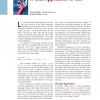Free Online Productivity Tools
i2Speak
i2Symbol
i2OCR
iTex2Img
iWeb2Print
iWeb2Shot
i2Type
iPdf2Split
iPdf2Merge
i2Bopomofo
i2Arabic
i2Style
i2Image
i2PDF
iLatex2Rtf
Sci2ools
INTERNET
2010
2010
A Chat Application in Lift
s the HTTP request–response cycle rather than wrapping HTTP concepts in APIs. This means you put HTML element definition and action in the same place: var name = "" SHtml.text(name, s => name = s) This example creates an <input type= "text" value=""/> tag and associates it with the function that sets the variable name to the value the user enters, whether submitted via Ajax or via a normal HTTP GET or POST. The advantages of Lift’s approach are numerous, including increased security through randomly assigned HTML element names, enhanced maintainability, and unification between Ajax and normal HTTP. Here, we show how to build a multiuser, realtime chat application in Lift and discuss Scala’s language features that make Lift possible. The application provides a single chat server that takes chat messages and redistributes the messages out to all listeners. But before we present the code for the chat application, let’s first briefly discuss S...
Actor | Actor’s Mailbox | INTERNET 2010 | Normal Http |
| Added | 28 Jan 2011 |
| Updated | 28 Jan 2011 |
| Type | Journal |
| Year | 2010 |
| Where | INTERNET |
| Authors | David Pollak, Steve Vinoski |
Comments (0)

